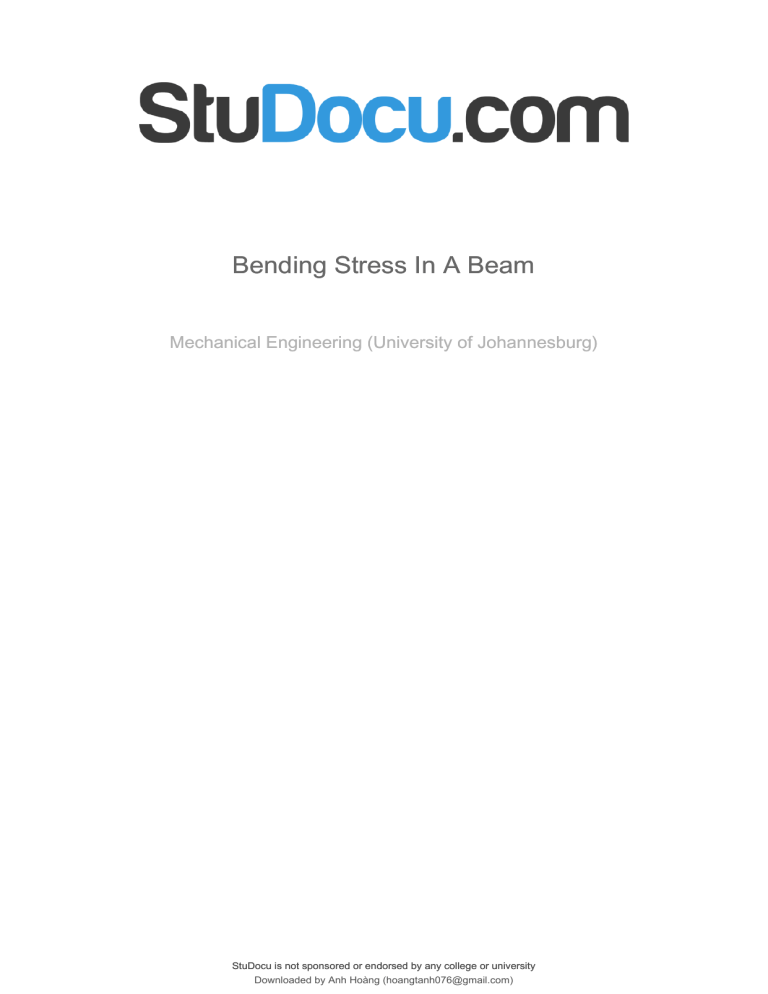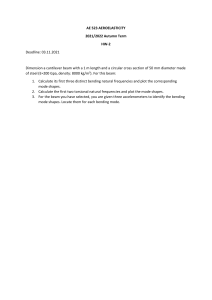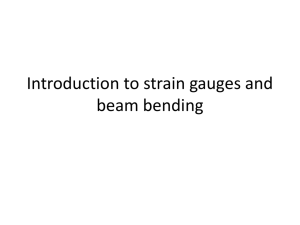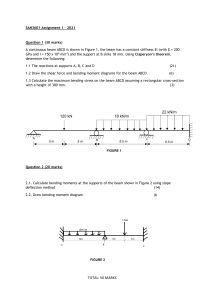
lOMoARcPSD|17823475 Bending Stress In A Beam Mechanical Engineering (University of Johannesburg) StuDocu is not sponsored or endorsed by any college or university Downloaded by Anh Hoàng (hoangtanh076@gmail.com) lOMoARcPSD|17823475 DEPARTMENT OF MECHANICAL ENGINEERING TECHNOLOGY Faculty of Engineering and Built Environment UNIVERSITY OF JOHANNESBURG Doornfontein Campus Title: Bending Stress in a Beam By ITEMOGENG.B. BABE (218002346) A Semester report submitted in partial fulfilment of the requirements for the module APPLIED STRENGTH OF MATERIALS 2B B. ENG TECH (BENG(TECH)) Engineering: Mechanical Date: 09 October 2020 Downloaded by Anh Hoàng (hoangtanh076@gmail.com) lOMoARcPSD|17823475 Table of Content: Introduction……………………………………………1 Aim…………………………………………………….2 Assumptions…………………………………………...3 Apparatus………………………………………………4 Procedure………………………………………………5 Results…………………………………………………6 Analysis of results……………………………………...7 Discussion………………………………………………8 Conclusion……………………………………………...9 Recommendations……………………………………..10 References……………………………………………...11 Appendix……………………………………………….12 Downloaded by Anh Hoàng (hoangtanh076@gmail.com) lOMoARcPSD|17823475 1. Introduction: Strain gauges are the most frequently used devices in stress-strain relation. The electrical strain gauge operates on the direct relationship between the change in electrical resistance of a wire as it is stretched and the strain developed within the material. The ability to precisely measure the change in electrical resistance gives a direct, precise measure of the strain. As a wire is stretched, its length increases and its cross-sectional area decreases, which increases the resistance of the wire. By bonding the strain gauge to a structural member and measuring the change in resistance as the load is applied, the corresponding strain can be measured. The experimental value of stress may be determined from the measured strain by using Hooke’s Law for uniaxial stress, = E. E is the modulus of elasticity of the beam material (Csun, n.d). 2. Aim: To calculate a bending Stress and compare it to the experimental value 3. Assumptions: Bending stress is zero at the beam’s neutral axis, which is coincident with the centroid of the beam’s cross section. Bending stress increases linearly away from the neutral axis until the maximum values at the extreme fibers at the top and bottom of the beam. Material of the beam is homogenous and isotropic. Beam is straight before loading and remains straight even after load is removed. Beam is stressed within elastic limit and follows Hooke’s law. 4. Apparatus: The STR3 Hardware with the frame Downloaded by Anh Hoàng (hoangtanh076@gmail.com) lOMoARcPSD|17823475 Figure 3 Data acquisition and Laptop computer 5. Procedure: 1. Set up the equipment as illustrated in Figure 3 and connect the laptop, which has an appropriate data capture software installed. 2. Zero the force gauge and the strain gauges 3. Load the beam with a force of 50 N and record the bending moment together with strain values from (1 until 9) on the laptop. 4. Repeat the same procedure by loading the beam with 100 N, 150 N, 200 N and the 250 N and each time recording the bending moment and strain values. 5. Tabulate your results as follows: 6. Results: Force Bending Gauge Gauge Gauge Gauge Gauge Gauge Gauge Gauge Gauge Moment 1 2 3 4 5 6 7 8 9 (N) (Nm) Downloaded by Anh Hoàng (hoangtanh076@gmail.com) lOMoARcPSD|17823475 50 100 150 200 250 8.7 17.7 26.2 35.2 44.0 326.5 278.0 240.7 202.9 158.9 218.7 179.6 149.9 121.3 88.5 343.5 309.3 285.2 260.3 230.7 208.9 200 191.6 184.5 175.4 113.9 109.5 106.2 103.9 98.9 6.8 8.6 8 8.7 11 0.5 19.4 35.7 51.4 69.1 -163.4 -149.7 -140.3 -129.5 -115.2 Take average value between two strains: Gauge Vertical Measured Bending moment (Nm) number Position (mm) 0 8.7 17.7 26.2 from top 1 0 0 326.5 278 240.7 2,3 8 0 281.1 244.45 217.55 4,5 23 0 161.4 154.75 148.9 6,7 31.7 0 3.65 14 21.85 8,9 38.1 0 -152.6 -135.7 175.35 7. Analysis of results: Calculations: Downloaded by Anh Hoàng (hoangtanh076@gmail.com) 35.2 44 202.9 190.8 144.2 60.1 -117.4 158.9 159.6 137.15 40.05 -96.75 -187.3 -155.5 -131.1 -105.3 -78.3 lOMoARcPSD|17823475 Centroid a1=6.4× 38.1 = 243.84 𝑚𝑚2 =2.4384×10^-4 m^2 a2=6.4×31.7 =202.88 𝑚𝑚2 =2.0288×10^-4 m^2 y1=6.4/2=3.2 mm y2=6.4+31.7/2=22.25 mm 𝑎1𝑦1+𝑎2𝑦2 y= 𝐴 (243.84)(3.2)+(202.88 )(22.25) = 243.84+202.88 =11.85mm 𝑦1 =38.1-11.85=26.25 mm 𝑦2,3 =30.1-11.85=18.25 mm 𝑦4,5=15.1-11.85=3.25 mm 𝑦6,7 =11.85-6.4= 5.45 mm 𝑦8,9 =11.85 mm Segment 1 2 A 243.84 𝑚𝑚2 202.88 𝑚𝑚2 𝑑𝑦 y 3.2 22.25 3.211.85=8.65mm 22.2511.85=10. 4mm I=bℎ3 /12 [(38.1)(6.4)^3]/12=832.3072 𝑚𝑚4 [(6.4)(31.7)^3]/12=1.6989×1 0^4𝑚𝑚4 Experimental stress E= 𝜎 𝜀 𝜕=𝐸 × 𝑒 = (69×10^9) (326.5×10^-6) =22528500 Pa Theoretical stress Moment of inertia about the neutral axis, I=𝐼1 + 𝐼2 = (832.3072 + 18.2×10^3) +(1.6989×10^4 +21.94 × 103 ) Downloaded by Anh Hoàng (hoangtanh076@gmail.com) A×𝑑𝑦 2 243.84×(8.65)^2=18.2×10^ 3 𝑚𝑚4 202.88× (10.4)^2 = 21.94 × 103 𝑚𝑚4 lOMoARcPSD|17823475 =58×10^3 𝑚𝑚4 =58×10^-9 𝑚4 𝑀𝑦 𝜕= 𝐼 = (17.7)(0.01185) Load 58×10^−9 50 100 150 200 250 =3616293.103 Pa Bending moment Experimental bending Stress Theoretical Bending Stress 8.7 17.7 26.2 35.2 44.0 22528500 19182000 16608300 14000100 10964100 1777500 3616293.103 5352931.034 7191724.138 8989655.172 Bending stress ×10^6 Bending stress vs Load 100 80 60 40 20 0 0 50 100 150 200 250 300 Load N experimental theoritical Figure 1: Bending stress against Load graph 8. Discussion: From the calculations above, it can be observed that the experimental stress is less than the theoretical stress. As observed in the graph above, it is seen that the graph of theoretical stress is increasing as the load is being increased and the graph of experimental values decreases as the load is being increased In the theory it is assumed that the distribution of the load is uniform and if the values obtains are not the same then it means the load distribution is not uniform. According to the graph above the experimental bending stress is showing linear relation with the load means the value of the experimental bending stresses increase with the increase in the value of applied load and decrease with the decrease in the value of applied load. Downloaded by Anh Hoàng (hoangtanh076@gmail.com) lOMoARcPSD|17823475 9. Conclusion: Aim of this task was to calculate a bending Stress and compare it to the experimental value and the result show that there is a linear relationship between bending stress and applied load. The strain is directly proportional to the bending moment. As the value of the bending moment increases, the value of the strain decreases. The bending equation predicts accurately the stress in the beam. It can be concluded that the experiment was partially successful, however the theoretical stress was greater than the experimental which could be due to human errors. 10.Recommendations: For the experiment to be successful and to obtain accurate readings or results, the following should be considered: The apparatus should be checked before starting with the experiment. The equipment in the lab should be either replaced or maintained in order to give accurate readings. More than one recording of readings should be considered to ensure certainty of each readings. Ensure that the apparatus is not vibrating that could cause inaccuracy of the results obtained. Take the average of the readings to perform the calculations. Downloaded by Anh Hoàng (hoangtanh076@gmail.com) lOMoARcPSD|17823475 11.References: I. II. Csun. (n.d). Available from: https://www.csun.edu/sites/default/files/EXP3.pdf. Accessed date: 07 October 2020. Scribd.com. figure 2. Accessed date: 08 October 2020 Downloaded by Anh Hoàng (hoangtanh076@gmail.com) lOMoARcPSD|17823475 12.Appendix: Figure 2: diagram of a beam Downloaded by Anh Hoàng (hoangtanh076@gmail.com)




